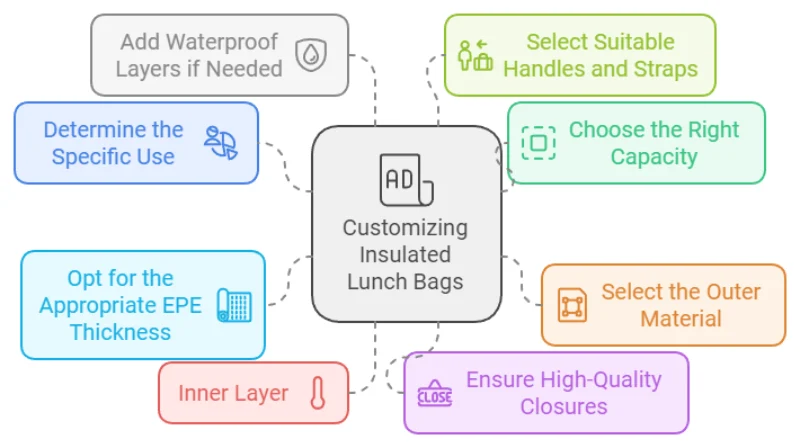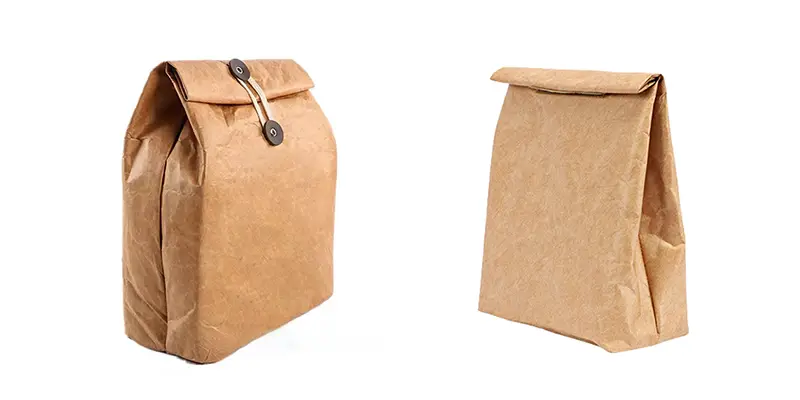Our Academy

In our daily lives, insulated lunch bags have become an essential item for many people. Whether it’s a busy workday, a trip, or a daily school lunch, a high-quality insulated lunch bag effectively helps us maintain the temperature of our food, ensuring its taste and freshness.
Have you ever noticed that after using an insulated lunch bag, hot food stays warm, and cold food remains cool and appetizing? According to studies, high-quality insulated lunch bags can keep hot food at the ideal temperature for up to 2-3 hours, while cold food stays cool for 4-5 hours. If you add ice packs, the insulation time can even extend to over 12 hours. This isn’t magic; it’s the application of scientific principles like heat conduction, convection, and radiation, using multiple layers of insulating materials to minimize the influence of external temperatures and ensure your food stays at its best.
Insulated lunch bags can keep hot food warm for 2-3 hours. True
Insulated lunch bags use materials like foam insulation and reflective aluminum foil to trap heat, allowing hot food to stay warm for 2 to 3 hours, depending on the bag's quality and the food's temperature.
The outer layer of insulated lunch bags is the most important for temperature control. False
While the outer layer provides durability and protection, the middle layer, made from materials like foam insulation or reflective aluminum foil, plays the key role in temperature control by reducing heat transfer.
The effectiveness of an insulated lunch bag does not rely on just one material or design; rather, it’s a combination of multiple layers and different materials working together to provide the best temperature control. Insulated lunch bags are typically made of three layers: an outer layer, middle layer, and inner layer, each with a specific function. Together, these layers work to keep food at the optimal temperature.
The outer layer usually does not directly affect the thermal control ability of the bag, but it plays a significant role in ensuring the bag’s durability and appearance. The materials used for the outer layer are diverse, and common options include: Non-woven (cheapest), Oxford fabric/Polyester, Cotton/Canvas, Laminated non-woven material, Laminated PP woven, Laminated RPET, Tyvek, Washable kraft paper, etc.
I previously wrote a detailed article about the outer materials of cooler bags. Click here to read more.

The middle layer is the core part of the insulation system, usually made of foam insulation or reflective aluminum foil. Each material helps maintain the internal temperature in different ways.
These two materials are often combined to form a composite middle layer, maximizing the insulation effect. Whether for hot or cold food, the middle layer plays a critical role.
While most insulated lunch bags are designed with only two layers, some high-end models add an inner layer to enhance waterproofing and cleaning functions. The inner layer is typically made from waterproof materials like PEVA or PVC, which not only prevent liquid leakage but also make the bag easier to clean.
The reflective properties of the aluminum lining also contribute to maintaining the temperature by reflecting heat.
The design of the bag’s closure also plays an important role in insulation. Common closure methods include zippers and Velcro, each helping to seal the bag and reduce the exchange of air between the inside and outside, thereby better maintaining the internal temperature.
Through a carefully designed multi-layer structure and different materials working in coordination, insulated lunch bags can effectively regulate internal temperatures, ensuring your food stays hot or cold, whether you’re at the office for lunch or on a long outdoor trip.

The effectiveness of an insulated bag depends on the thickness of the insulation layer, external temperature, and the use of additional tools. Generally, untreated hot food can maintain its temperature inside the bag for 2 to 4 hours. Preheating the bag or container with hot water and adding heat packs can extend the duration to 4 to 6 hours. For cold food, without ice packs, the temperature can be maintained for 2 to 4 hours, and with ice packs or frozen gel packs, this can be extended to 6 to 8 hours. Additionally, environmental temperature has a significant impact on the performance of the insulated bag. Extreme heat or cold may shorten the time the bag can maintain its internal temperature. For optimal results, it is recommended to preheat or pre-chill the food before placing it in the bag and minimize the number of times the bag is opened to maintain temperature stability.
Typically, there are two ways to enhance a cooler bag’s performance:
1) Improve the design of the lunch bag itself, and
2) Use clever tips to maximize its temperature control.
Multi-layer Insulation Design
Sealing Design A good sealing design can reduce the amount of external air entering the bag and prevent heat from escaping. Common sealing methods include:
Size and Shape The size and shape of the cooler bag affect temperature control. Select a size that fits your food to avoid too much air space inside. Empty space allows heat to escape more easily, affecting insulation.

In addition to choosing the right design, you can also use some clever tricks to further extend the food’s temperature retention. Here are a few practical tips:
By following these tips, you can easily optimize your insulated lunch bag, ensuring that your food stays at the right temperature for longer.
Ice packs can extend the cooling effect of insulated lunch bags to over 12 hours. True
Adding ice packs or gel packs to insulated lunch bags can significantly extend the cooling time, helping the contents stay cold for up to 12 hours or more.
Velcro closures provide a better seal than zippers for temperature control. False
Zippers create a tighter seal than Velcro closures, which helps minimize air exchange and maintain internal temperatures more effectively. Velcro is easier to open and close but is less airtight.
Such advantages of cooler bags have made them a necessary tool in people’s lives, especially when they are needed to maintain the right temperature for meals and drinks.

Improving the performance of your current insulated lunch bags is important. However, if you’re a business looking to promote your brand with customized bags, there are several factors to consider. Here’s how you can make the most of your investment:
Identify its target audience and how they will use the insulated lunch bags. Are your client’s bookstores, art supply stores, wine stores, farmers’ markets, or cafes and bakeries? Knowing this will help you select the right features and design the application effectively.
For instance, customers can use these bags to preserve foodstuffs, carry drinks, and facilitate medical and other outdoor activities.
This way, you make the bags relevant to the needs of the target consumers, whose needs and convenience you will have considered in the bag’s design.
When selecting the bag’s capacity, it’s important to consider your customers’ needs.
Smaller bags are ideal for carrying individual lunch portions, making them suitable for daily consumers like workers or students. On the other hand, larger bags are ideal for group use or carrying multiple items. They are perfect for event planners, picnickers, or businesses. By tailoring the bag’s size to your customer’s needs, you enhance its functionality and appeal.

Your company’s budget and market position are major factors in deciding the outer material.
Essentials that will come in contact with different materials come in various prices and their sturdiness. If your brand is to operate in a premium segment, it is likely profitable to invest in better materials.
However, if budget is a significant concern, some products, though offering subpar performance, are more budget-friendly. Choosing the right material involves balancing what is financially feasible with the image you want to project to your customers.
Insulation is key to maintaining the temperature of the bag’s contents. EPE foam, typically 1.5-3MM thick, is commonly used. Thicker foam provides better insulation but can increase shipping costs. Balancing insulation efficiency and cost-effectiveness is essential.
Aluminum foil is an excellent choice for the inner layer, as it is reflective and insulator. It helps maintain the desired temperature, enhancing the bag’s functionality, whether for keeping items hot or cold.

Purchase appropriate packaging zippers or Velcro for the dikes to make a tight seal to avoid compromising food freshness. This eliminates the bag’s coming in of cold air or out of hot air and hence enhances its efficiency. Error-free Closure also improves the appearance of the user interface and enriches the product’s brand image.
If the cooler bag is intended for long-term use rather than as a promotional giveaway, consider using inner lining materials with higher water resistance and durability, such as PEVA or TPU. These materials can effectively prevent stains from penetrating and are easy to wipe clean. Additionally, it is recommended to use waterproof materials at the seams to further enhance ease of cleaning.
Choose handles and straps based on the bag’s intended use. For smaller bags, a single handle or two handles might be sufficient. Adding reinforced handles or a comfortable shoulder strap can improve usability for more significant outdoor bags. This consideration demonstrates thoughtfulness towards your customers’ convenience.
By choosing the right features, you can produce insulated lunch bags that not only serve their intended purpose but also effectively showcase your brand. Bags that are not just visually appealing, but also functionally sound, will be well-received by customers. This positive experience will leave a lasting, positive impression on the clients you serve, reinforcing your brand’s reputation.
Ensure that the cooler bag is compatible with common food containers, such as lunch boxes, beverage bottles, or thermos cups. Good compatibility allows for efficient use of internal space and helps prevent food from spilling or leaking during transport. Some cooler bags can be designed with adjustable dividers or fixed pockets to secure containers of various shapes, enhancing convenience and improving the overall customer experience.
Adding extra pockets and compartments can enhance the functionality and convenience of the cooler bag. External pockets are suitable for storing utensils, napkins, or small items, while internal compartments can separate different types of food to prevent mixing or cross-flavors. A well-organized layout ensures that items remain stable during transport, further improving the user experience.

Reflective aluminum foil in insulated lunch bags helps keep food both hot and cold. True
Reflective aluminum foil reflects thermal radiation, which helps retain heat for hot food and prevent external heat from entering when storing cold food, enhancing the bag’s insulation properties.
All cooler bags are leakproof by default. False
Not all cooler bags are leakproof. Only those with heat-pressed PEVA or PVC linings and no stitched seams offer high anti-leakage performance.
In conclusion, insulated lunch bags are an essential tool for anyone looking to maintain the freshness and temperature of their meals, whether for work, school, or travel. By utilizing advanced materials like foam insulation and reflective aluminum foil, these bags are designed to keep hot foods warm and cold foods cool for several hours. With the right design and clever tips—such as pre-chilling, using ice packs, and minimizing bag openings—you can enhance their performance and ensure your meals stay at the ideal temperature for longer. Whether you are choosing a lunch bag for personal use or looking to promote your brand with customized designs, investing in high-quality insulated bags will always pay off in terms of convenience, functionality, and satisfaction.
Looking for a reliable partner for insulated lunch bag contract manufacturing? Yanxin Bag specializes in custom cooler bags and wholesale lunch cooler bags with excellent insulation and customizable branding. Contact Yanxin Bag today to start your contract production and bring your custom insulated lunch bags to market with confidence.
This guide uncovers the science, materials, usage tips, and niche innovations behind insulated lunch bags. To explore specific topics further, we’ve curated our most valuable supporting articles below.
7. Make It Yours: How to Customize Cooler Bags for Brand Impact
8. Insulated vs. Cooler Bags: Know the Difference Before You Buy
Get a free quote and expert consultation today. Let's bring your brand vision to life.
1 The United States Department of Agriculture (USDA) sets national food safety guidelines and offers official public guidance on handling and storing food.
2 While materials like PVC or PEVA provide excellent waterproofing and durability, the U.S. Environmental Protection Agency (EPA) notes that vinyl chloride—the base chemical used to make PVC—is currently under risk evaluation for potential environmental and health impacts.
Answer: An insulated bag is a thermal container designed to keep food and beverages at an ideal temperature (whether hot or cold) for an extended period. It works by using a multi-layer structure made of insulating materials like foam, reflective foil, or aluminum to trap air and reduce heat transfer. Some insulated bags also use gel packs or ice packs to extend the cooling effect.
Answer: The duration for which an insulated bag can keep food cold depends on several factors, including the type of insulating material, the size of the bag, and whether ice packs or gel packs are used. Generally, a well-insulated bag can keep food and beverages cold for 4 to 6 hours. If ice packs or gel packs are added, this time can be extended to 12 hours or longer.
Answer: Yes, an insulated bag can keep hot food warm for a limited time. The insulating materials inside the bag reduce heat transfer, helping to retain warmth. Hot food can usually stay warm for 2 to 3 hours. If you need to keep it warm for a longer period, consider using a heated lunch bag or adding heat inserts.
Answer: While some insulated bags have enough insulating properties to keep food cold for a few hours, using ice packs or gel packs can significantly enhance the cooling effect. They help lower the internal temperature and maintain it for a longer period, especially when transporting perishable foods like meat, dairy, or beverages.
Answer: The outer materials of insulated bags vary, commonly including: Non-woven (cheapest), Oxford fabric/Polyester, Cotton/Canvas, Laminated non-woven material, Laminated PP woven, Laminated RPET, Tyvek, Washable kraft paper, etc.
Answer: Yes, many insulated bags are versatile and can be used for both cold and hot food. However, depending on the type of food, you might need to use different methods. For cold food, ice packs or gel packs are more effective, while for hot food, ensuring the bag is well-sealed and avoiding exposure to air helps maintain warmth.
Answer: When cleaning an insulated bag, first empty all contents and any leftover ice or food debris. Generally, you can wipe it down with a damp cloth or sponge. If stains are more stubborn, gently scrub the soiled area with a small brush, being careful to avoid printed areas like screen printing or heat transfers. After cleaning, ensure the bag is completely dry to prevent mold or mildew growth.
Answer: The size of the insulated bag you choose depends on the amount of food and beverages you need to carry. For single-day use or short trips, a compact insulated bag is ideal. For longer trips or picnics, you may need a larger bag with multiple compartments for drinks, food, and ice packs. Be sure to consider the number of people you’re catering to and the types of food you need to store.
Answer: Yes, insulated bags are perfect for transporting groceries, especially perishable items like meat, dairy, and frozen foods. They’re great for keeping food cold when shopping at the supermarket or transporting food from the market. To improve cooling, consider using ice packs or gel packs inside the insulated bag to maintain the cold effect for longer.
Answer: To keep food cold for 8 hours:

Order or no-order we are Always here to help you!
We will contact you within 1 working day, please pay attention to the email with the suffix “@yanxinbag.com”.
Order or no-order we are Always here to help you!
We will contact you within 1 working day, please pay attention to the email with the suffix “@yanxinbag.com”.